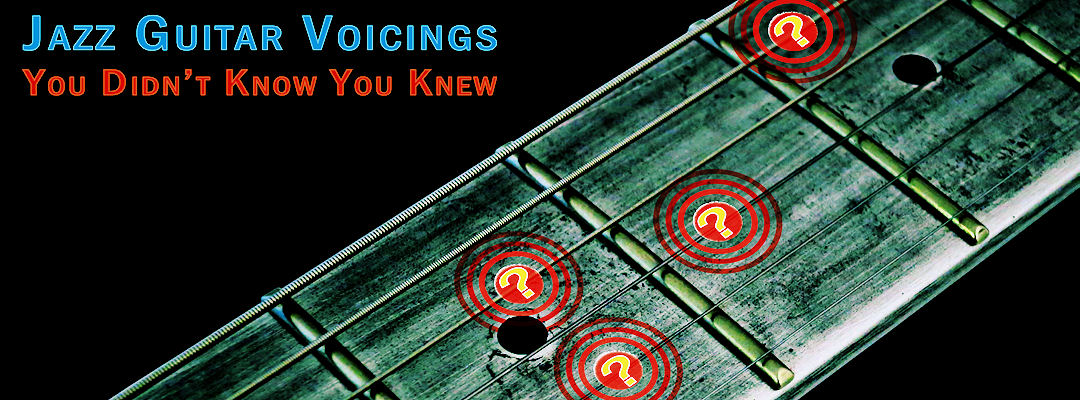
Hey peeps, I’m coming to you through this first post to talk a little bit about one of the most important things in group playing: providing accompaniment, or “comping”, in particular, voicings.
In a jazz playing context, if you’re a harmonic instrument (guitar, piano etc) you’ll find yourself more often than not taking up the role of accompanist for other instruments or singers, that is, to provide rhythmic, harmonic and dynamic context and contrast to the soloist or singer, in short make their already good stuff sound awesome. Effective comping involves many different elements but for today we’ll focus on the voicing element of harmony.
Everyone will tell you an accompanist’s chordal palette should be as wide and diverse as possible, the more chord voicings (which notes and in what order you use them to build you chord) you know the better, and while that is certainly true there is a lot to getting the most mileage of all the voicings you already know.
Utilizing Familiar Jazz Voicings In a Different Function
On this post we will cover how to utilize a particular chord voicing in a different function. Meaning, let’s say you have a CMaj7 (for simplicity’s sake), you can obviously use it as CMaj7 chord but it would also be great for an Amin7(9).
Ex: 1
The same method would also work with different inversions of that voicing.
Ex: 2
Regardless of the inversion what matters is that we are playing a CMaj7 voicing over an “A” root note creating a Am7(9) voicing.
In detail:
CMaj7 is comprised of the notes “C”, “E”, “G” and “B” meaning Root, M3, P5 and M7 respectively.
Playing those notes over an “A” would give us (in relation to “A”) a m3, P5, m7, M9 meaning Cmaj7/A = Am7(9). Following the same process of superimposing a chord voicing let’s discover all the sounds we can get from CMaj7 just by playing it over different root notes:
- CMaj7/C – C (R), E (M3), G(P5), B(M7) = Cmaj7
- CMaj7/Db – C(M7), E(m3), G(b5/#4), B(m7) = DbmMaj7(7)
- CMaj7/D – C(m7), E(2), G(P4), B(M6) = D7sus4(9,13)
- CMaj7/Eb – C(M6), E(b2), G(M3), B(b6) = Eb(b9, b13, 13)
- CMaj7/E – Inversion of CMaj7 = CMaj7/E
- CMaj7/F – C(P5), E(Maj7), G(M2), B(#4) = Fmaj7(#11) omit 3
- CMaj7/F# – C(b5), E(m7), G(b9), B(P4) = F#7sus4(b9, #11)
- CMaj7/G – Inversion of CMaj7 = Cmaj7/G
- CMaj7/Ab – C(M3), E(m6), G(Maj7), B(m3) = AbMaj7(#9,b13)
- CMaj7/A – C(m3), E(P5), G(m7), B(M2) = Am7(9)
- CMaj7/Bb – C(M2), E(#4), G(M6), B(b9) = Bb(b9,9,#11,13)
- CMaj7/B – Inversion Of CMaj7 = Cmaj7/B
That means that if you play a CMaj7 against any particular root notes these are the sounds that you’ll hear. Some of them are very readily useful, some not as much and others still may require some tweaking to fit our purposes but they all have individual sounds that you want to use at some point. Here’s an example of this concept: only using Maj7 voicings on a chord progression, in this case a very common minor II V I.
Ex: 3a – Basic Progression:
The original progression is Emin7(b5), to A7, to Dmin7, and, looking for appropriate sounds from the table above we’ll superimpose Maj7 vocings. For this example I’ll use BbMaj7/E, DbMaj7/A and FMaj7/D respectively and by doing that we’ll get some beautiful tensions in the progression.
Ex: 3b – Substitute voicings:
Ex: 3c – Translating the substitutions:
Now, I know some of you will have spotted the lack of a minor third in our Emin7(b5) and the lack of a minor seventh in our A7. I assure that with the context of the chord progression that won’t matter and the cadence sound will remain. However you can always tweak your voicing to get those notes back in there.
Ex: 4 – Tweaking the voicings:
Play all the above progressions and listen for the different sounds, and I guarantee you’ll find some very applicable uses right away.
Finally, I should mention that in an ensemble playing situation the root notes over which you play your chords are implied either by context or by the bass player, meaning you can focus on playing just the superimposition.
It’s also important to note that you could and should go through the same process with any type of chord, major, minor, dominant and etc.
I’d recommend that you familiarize yourself with some of those sounds and start using those you particularly like and then even apply this concept to a whole song progression.
With that in mind I am including a version of “All The Things You Are” where I use the techniques described in this post.
Ex. 5 – Chord Progression (All The Things You Are):
Have fun!
_________
NY Ensemble Classes is a jazz school located in New York City, in the heart of Manhattan. We teach ensemble classes in a very special way, like no one else in the city, read more!












